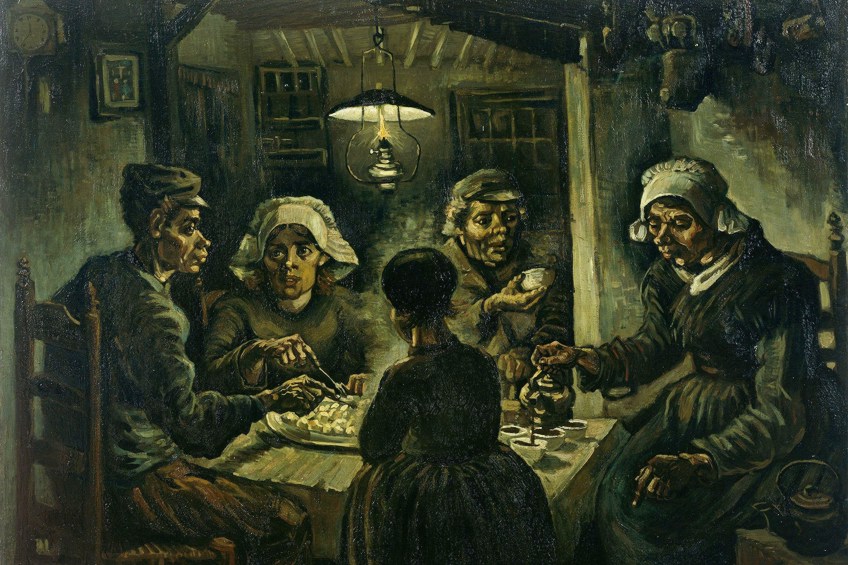“The Potato Eaters” Van Gogh – Analyzing “The Potato Eaters” Painting
The famous Vincent van Gogh, who painted The Potato Eaters in 1885, held his painting in high esteem after it was completed. Unfortunately, this Dutch artist was up against the whole world who seemingly held it in low esteem. In this Van Gogh The Potato Eaters analysis we explore in more detail what is now regarded as one of van Gogh’s masterpieces.
Artist Abstract: Who Was Vincent van Gogh?
Vincent Willem van Gogh was born on the 30th of March 1853 and lived until he was 37 years old, dying on the 29th of July 1890. He started his art career later in life, around 1880, after being an art dealer, teacher, assistant, and missionary. He was a religious man too and had a desire to help those in need. He was financially supported by his brother Theo van Gogh; the two brothers often wrote to one another.
He lived in different countries and cities throughout the course of his life, places like London, Paris, Amsterdam, and the Netherlands. From 1885 to 1886 he studied drawing and painting at the Royal Academy of Fine Arts in Antwerp.
Although he suffered from mental and physical health problems, Van Gogh was never a person who followed the rules – in both art and society, and who lived according to his own yearnings and ideas.

The Potato Eaters (1885) by Vincent van Gogh in Context
Below we aim to provide a Vincent van Gogh The Potato Eaters analysis, starting with a brief contextual analysis around where and why the artist painted it and what motivated him to portray peasants in their home. We will then discuss a formal analysis of van Gogh’s stylistic applications, including a more detailed look at the subject matter.
| Artist | Vincent van Gogh |
| Date Painted | 1885 |
| Medium | Oil on canvas |
| Genre | Genre painting |
| Period / Movement | Post-Impressionism |
| Dimensions | 82 x 114 centimeters |
| Series / Versions | Not applicable |
| Where Is It Housed? | Van Gogh Museum, Amsterdam |
| What It Is Worth | The painting was a part of Van Gogh’s family, after which it was part of the Vincent Van Gogh Foundation. It could be considered priceless; however, its estimated worth would be in the millions of dollars. |
Contextual Analysis: A Brief Socio-Historical Overview
Van Gogh once wrote to his sister, Wilhelmina, that he thought The Potato Eaters painting was “the best thing” he did. He defended himself against his then friend, Anton van Rappard, who heavily critiqued van Gogh’s painting saying that the artist could “do better”. However, ironically this painting became revered by the world and one of van Gogh’s most famous.
So, why did van Gogh create “The Potato Eaters” painting?
What was he experiencing and believing in his life when he painted it? Reportedly, van Gogh lived in the town called Nuenen, Netherlands, with his parents. He moved there around December 1883 from Drenthe, where he lived previously. Reportedly, due to his loneliness and his love of the country, he decided to live in Nuenen, which is where he started his series of studies of peasant life, known as Peasant Character Studies (1881 to 1885).

This consisted of peasants involved in various tasks or skills like farming, basketry, weaving, digging, sowing seeds, shepherds, and various groups of people also working and eating together. Van Gogh was deeply attracted to the peasant lifestyle and avidly studied it through his numerous sketches and paintings, which numbered to over 200 in his collection.
Furthermore, van Gogh sought to portray the peasants and their activities in pure light, albeit with darker and earthier shades of color. He wanted to portray the “essence” of what he undoubtedly saw and felt when he was immersed in this type of life in Nuenen, which was hardworking, simple, yet respectable; he reportedly worked as a peasant to experience it firsthand.
However, this also points to an interesting side of Vincent van Gogh that many may not know about. Most of us may associate him with madness or as that artist who chopped off his own ear, but there was more to van Gogh than mere madness, so to say.
During his earlier years, he also studied to become a minister; he was religious, but his missionary studies did not work out. However, he did work as a missionary in one of Belgium’s coal-mining districts. He was also devout to living a simple life and had a spirit that wanted to be of service to others, to help them in their needs.
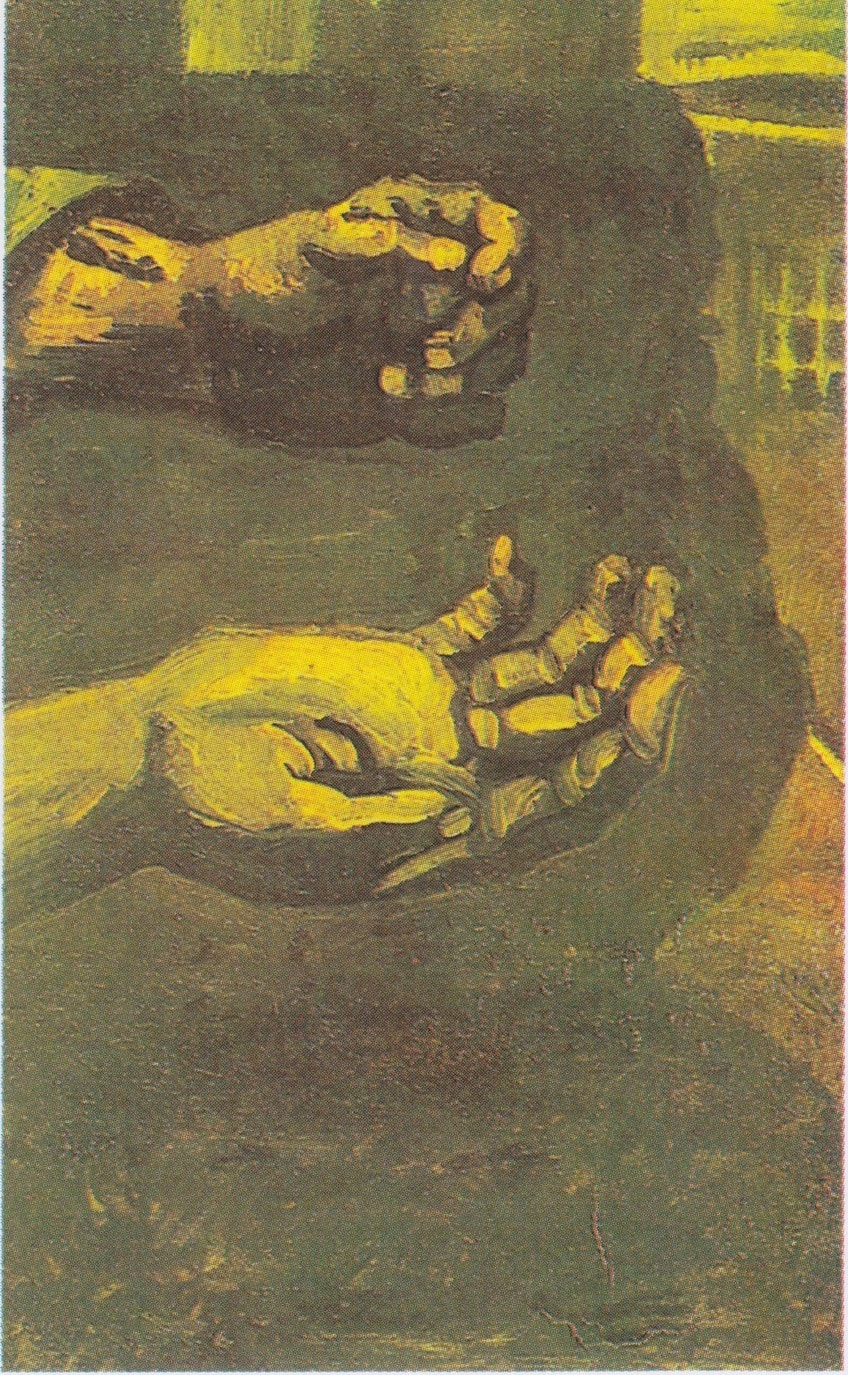
He was notably interested in people who were, as Robert Wallace describes in his publication The World of Van Gogh 1853 – 1890 (1969), “destitute and downtrodden”; van Gogh also read numerous authors’ works who also explored this “subject”.
Another factor that motivated van Gogh to focus on the simple aspects of life, as well as the more rural aspect of life, was the burgeoning Industrialization and urban lifestyles. This affected van Gogh, and he also wrote about how he felt sad that these places he used to love changed with the development of railways and factories.
A “Real Peasant Painting”
Van Gogh did not want people to commend The Potato Eaters painting without understanding the reason behind it. He wrote that he wanted people to “get the idea that these folk, who are eating their potatoes by the light of their little lamp, have tilled the earth themselves with these hands they are putting in the dish, and so it speaks of MANUAL LABOUR and – that they have thus honestly earned their food”.
For van Gogh, it was important to portray peasants in their realness and truth, and he also explained to his brother that painting the lives of peasants is “serious”.
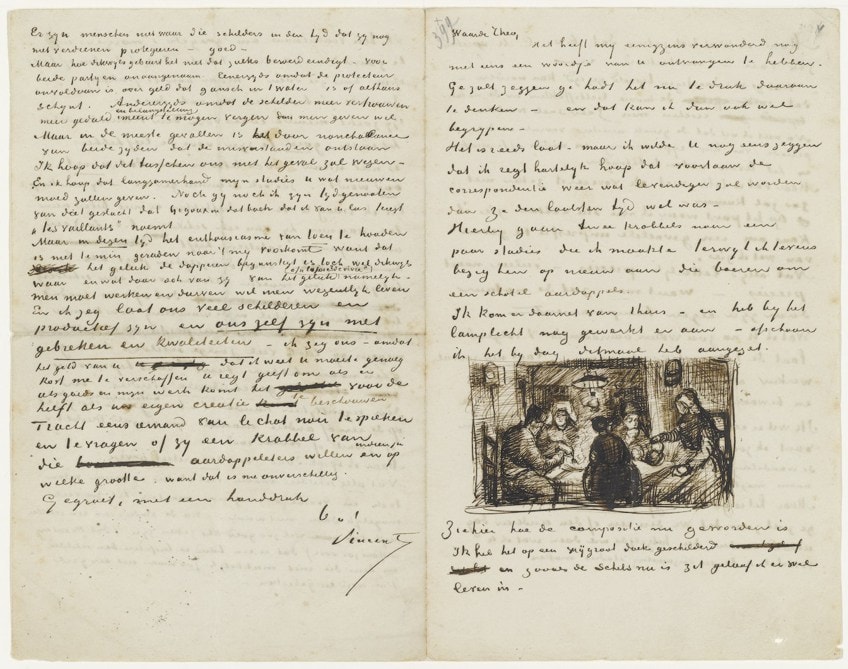
In his aim to convey this realness he chose to portray them in their “coarseness”, explaining how he prefers a gentleman or a lady in peasant garb rather than wearing more formal garb from society. He did not want to create what he described as “conventional smoothness” in a painting about peasants. Van Gogh also believed peasants needed to be painted as if the artist was one of them, additionally expressing that he thought peasants lived in a “world” of their own, better than the “civilized” world.
This all originated from van Gogh’s perception of his work, believing that it was a “real peasant painting” as he explained to his brother.
Van Gogh made numerous studies of peasants and their physical appearances. He mentioned to his brother Theo that it did not take a long time to paint, however, it took most of the winter to study how to paint the peasants’ hands and heads. He also employed several models for his production of The Potato Eaters painting.

One of the families he painted in Nuenen was the De Groot family. He reportedly painted in their cottage and found them sitting around their table eating, which is what gave him the idea to paint them, culminating in The Potato Eaters painting.
An interesting fact is that one of the figures in The Potato Eaters is possibly Gordina De Groot, who was one of the women he often painted in his peasant painting studies. She is possibly depicted as the woman sitting to the left-hand side of the table facing us, the viewers.
Formal Analysis: A Brief Compositional Overview
Let us take a closer look at Vincent van Gogh’s The Potato Eaters painting, starting with the subject matter and then formal elements like color, which has been a point of contention for Van Gogh due to it being considerably dark.

Subject Matter
In The Potato Eaters, van Gogh depicts an interior setting where five people sit around a small square table. There is a light dangling from the ceiling in the center of the table. The family is busy eating supper, as is surmised by the dark outdoors through the windows towards the background as well as the clock on the left-hand wall, in the upper left corner, displaying that it is seven o’clock.
The figure to the left is busying himself with the platter of steaming potatoes, holding a fork in his right hand, as is the figure to his left. The girl is also getting herself potato pieces with the fork in her right hand (our left). She also appears to be looking at the male figure to her right.

To this girl’s left is a more centralized figure of a woman holding a cup up in her right hand. She appears to be looking in the direction of the woman to her left, who is pouring what looks like coffee into four white cups, for herself and the others at the table. Her gaze is focused on the pot of coffee.
Her left forearm and hand rest gently on her lap while she pours, and most of her figure is more in view, whereas the others are blocked by the table.
The figure sitting to the latter-mentioned woman’s left sits with her back to us, the viewers. We cannot deduce much about this figure, except that she appears quite young due to her being smaller in body stature than the other figures. She possibly has her fork in the platter of potatoes too.

The rest of the room around the figures is quite simple with what appears to have minimal items. The interior is also a small space, and the figures look cramped into their space. Towards the left and right of the composition, there are several items hanging on the edges of the ceiling. As mentioned, the clock is in the top left corner, and next to it is a small picture frame. To the right, there are various utensils. In the bottom right corner is another pot on the edge of a table.
This is undoubtedly a kitchen and dining room space.

Beyond the five figures, there appears to be another space, possibly a living room area with two windows on the background wall. This space is not in our view, however, there is a door visible in the background on the left-hand sidewall.
It is also important to note the entire interior space is quite dark.
There is only one source of light, which hangs above the five figures and the table, shedding light mostly on them, leaving the rest of the space in semi-darkness. However, this light source also allows us to view the figures’ faces in more detail.
An interesting fact is that when van Gogh painted this, he was still practicing the nuances that come with painting. Sources also state that he had difficulty painting various features, like the hands, with anatomical correctness.
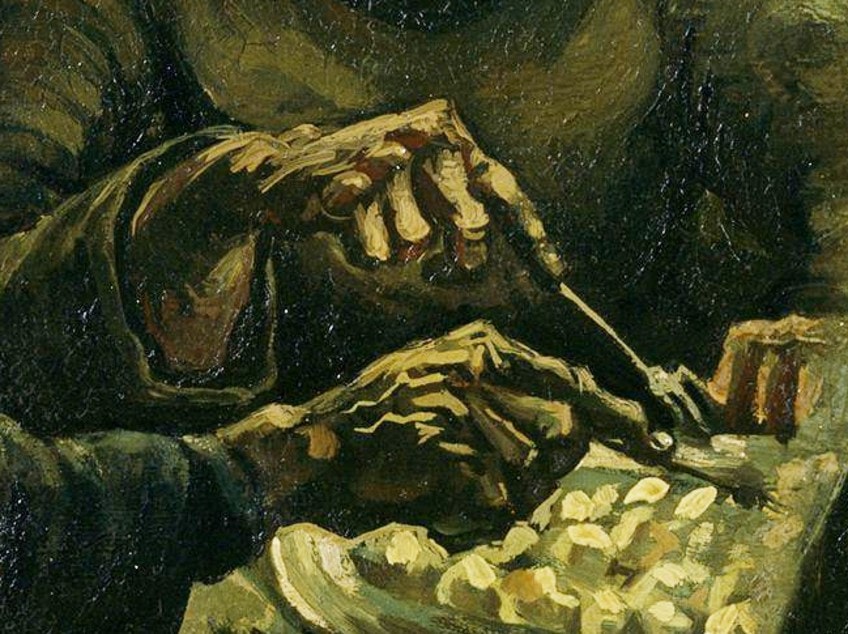
However, through van Gogh’s apparent difficulties with painting, he nonetheless managed to portray the figures in their realness. If we look at their hands and faces, they appear worn and weathered, quite bony, and not as nourished as we would expect from a thriving person, but this all adds to the honesty of the subject matter and their immersion in manual labor. Furthermore, they are eating the fruits of the labor.
Color and Light
We might wonder, what colors did Vincent van Gogh use in his painting The Potato Eaters? He painted the composition with dark colors, which also informs the subject matter. As mentioned above, there is also only one light source illuminating the figures and the items on the table, which creates an interesting stylistic dynamic for the entire composition.

There are a lot of earthy tones in this composition – browns, blacks, and a general grayed space. In a letter to his brother Theo, Vincent van Gogh wrote about his choices of color. He mentioned how dark it was and that he did not really utilize a white color, explaining the neutral color that forms from mixing.
He explained, “red, blue, yellow together – say vermilion, Paris blue and Naples yellow. So this colour in itself is a fairly dark grey, but it looks white in the painting”.
Van Gogh also explained to Theo that the interior space is lit by the lamp in the center, which makes it appear dark gray. He described that the light of the lamp is a “red gold glow” that appears “lighter” than white. He further described the peasants’ skin tones, noting that the flesh color was initially painted in “some yellow ochre, red ochre and white”, but it was too light for him, and he changed their color to what he described in the letter as, “something like the colour of a really dusty potato, unpeeled of course”.

Although Van Gogh painted what appears to be a neutral and dark-colored painting, in fact, he created it by combining various colors to achieve the desired shades. It also hints at the artist’s care and attention to how he wanted the painting to look and feel. The subject matter and colors ultimately become an interdependent combination.
Brushwork
In The Potato Eaters, van Gogh utilizes expressive and loose brushstrokes. The composition is painted with an assortment of different thicknesses of brushstrokes, which create an overall unified space. We see the lighter-colored brushstrokes highlighting aspects, for example, on the figures’ hands, this similarly highlights where the light falls on them from the light source above.
The light is painted in sharp strokes of paint, which also gives it a naturalism.

This is not the typical painting we would expect to see from a painter at the Paris Salon, it depicts an artistic style not preoccupied with following the rules of painting, but of creating a composition, that although it appears scraggly in its brushwork, it undoubtedly depicts the essence of what van Gogh sought to portray.
The Potato Eaters Painting: A Labor of Love
Van Gogh created several versions, or studies, of The Potato Eaters painting, namely the oil sketch at the Kröller-Müller Museum in the Netherlands, a couple of other studies, and a lithograph.
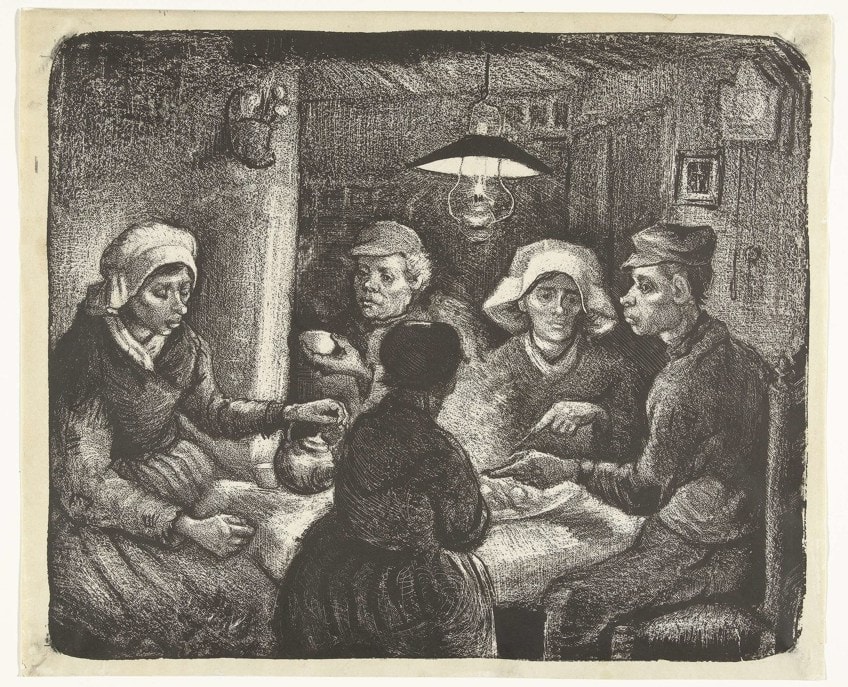
In “The Potato Eaters”, van Gogh created a scene that was not so much concerned with the formal rules of painting, but the portrayal of peasants, their lifestyle, and what they stood for in the world. Van Gogh did away with any pretense, whether stylistically or contextually, and spotlighted a moment of truth between five people at a table. For him, it was a labor of love.
Read also our van Gogh potato eater web story.
Frequently Asked Questions
Who Painted The Potato Eaters?
The Potato Eaters (1885) was painted by the Dutch artist Vincent van Gogh, who also painted the popular The Starry Night (1889) painting. He did not gain a lot of recognition for The Potato Eaters painting and his artistic abilities were criticized, however, it became one of his most recognized artworks.
What Colors Did Vincent van Gogh Use in His Painting The Potato Eaters?
Although The Potato Eaters (1885) appear to be painted in simple dark colors, van Gogh did in fact paint with an assortment of colors, for example, browns, red ochre, yellow ochre, blues, and many more to achieve the overall neutral and gray lighting.
What Does Van Gogh’s The Potato Eaters Painting Mean?
In The Potato Eaters, Van Gogh depicts an authentic and truthful peasant life and how it is different from what he described as civilized life. People who work in the fields and grow their own food. Furthermore, he wanted to depict people who have earned their food from the hard work they put in. He also explored his artistic skills, as this was one of his earliest and first paintings.
Alicia du Plessis is a multidisciplinary writer. She completed her Bachelor of Arts degree, majoring in Art History and Classical Civilization, as well as two Honors, namely, in Art History and Education and Development, at the University of KwaZulu-Natal, South Africa. For her main Honors project in Art History, she explored perceptions of the San Bushmen’s identity and the concept of the “Other”. She has also looked at the use of photography in art and how it has been used to portray people’s lives.
Alicia’s other areas of interest in Art History include the process of writing about Art History and how to analyze paintings. Some of her favorite art movements include Impressionism and German Expressionism. She is yet to complete her Masters in Art History (she would like to do this abroad in Europe) having given it some time to first develop more professional experience with the interest to one day lecture it too.
Alicia has been working for artincontext.com since 2021 as an author and art history expert. She has specialized in painting analysis and is covering most of our painting analysis.
Learn more about Alicia du Plessis and the Art in Context Team.
Cite this Article
Alicia, du Plessis, ““The Potato Eaters” Van Gogh – Analyzing “The Potato Eaters” Painting.” Art in Context. January 25, 2022. URL: https://artincontext.org/the-potato-eaters-van-gogh/
du Plessis, A. (2022, 25 January). “The Potato Eaters” Van Gogh – Analyzing “The Potato Eaters” Painting. Art in Context. https://artincontext.org/the-potato-eaters-van-gogh/
du Plessis, Alicia. ““The Potato Eaters” Van Gogh – Analyzing “The Potato Eaters” Painting.” Art in Context, January 25, 2022. https://artincontext.org/the-potato-eaters-van-gogh/.


